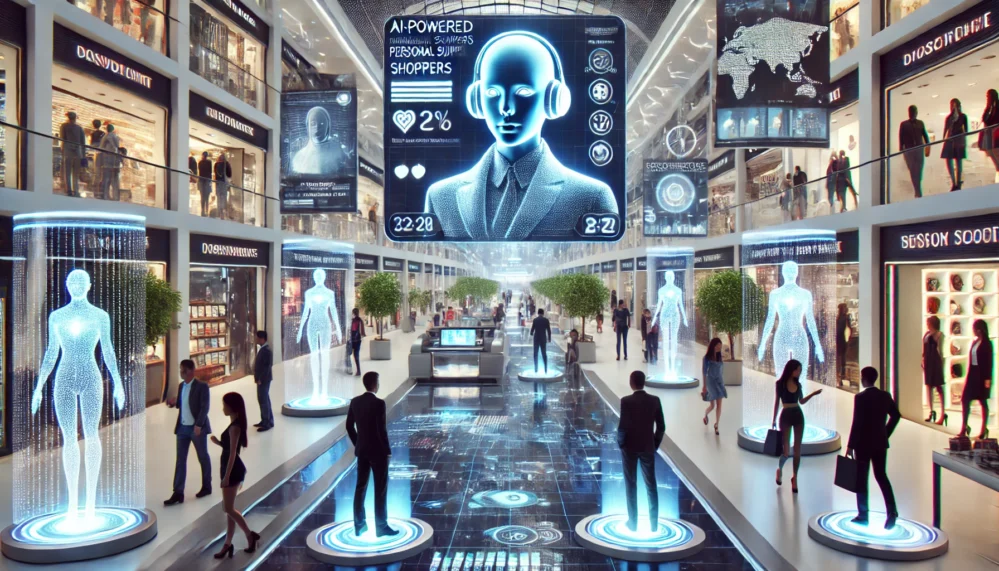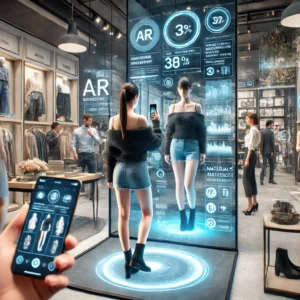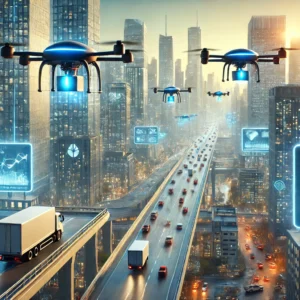
Imagine strolling down a digital marketplace where every item on your shopping list appears as if by magic—a virtual assistant that not only knows your tastes but anticipates your needs even before you realize them yourself. This is no distant fantasy; it’s the present-day marvel of the AI-Powered Personal Shopper. With the fusion of advanced algorithms and a sprinkle of futuristic charm, your shopping experience is being completely redefined.
A Glimpse into the Virtual Shopping Revolution
In today’s rapidly evolving digital ecosystem, traditional shopping is taking a backseat as technology carves out a new frontier. A sudden, almost whimsical shift in consumer behavior has led to the rise of virtual shopping assistants. These AI-powered systems harness vast amounts of data and transform it into tailored recommendations that feel almost human. At times, you might catch yourself wondering if these digital helpers possess an uncanny intuition, blending machine precision with a touch of personality.
The journey into this brave new world isn’t without its quirky moments. One minute you’re comparing prices, and the next, your personal shopper is suggesting a pair of eco-friendly sneakers based on an obscure blog post you read last week. It’s a bit like having a conversation with a friend who remembers every detail about your style—albeit one that occasionally throws in a dash of unpredictability.
How Virtual Assistants Curate Your Shopping List
At its core, the AI-Powered Personal Shopper leverages machine learning, natural language processing, and a host of other advanced technologies to decode your preferences. It’s a blend of art and science. Algorithms analyze your past purchases, browsing history, social media interests, and even subtle cues from your online interactions. This wealth of data is then translated into product suggestions that feel meticulously curated, much like a boutique stylist who knows you better than you do.
Yet, it’s not all smooth sailing. While the majority of recommendations hit the mark, sometimes the suggestions might seem slightly off—almost as if the system is experimenting with an untested hypothesis. But isn’t that part of the charm? In a way, these small stumbles add personality to an otherwise polished digital experience, reminding us that even sophisticated AI has its quirks.
Government Insights and Regulatory Perspectives
Now, let’s shift gears and consider a more formal dimension of this digital revolution. Governments across the globe are not just passive onlookers but active participants in shaping the regulatory landscape for AI in shopping. Regulatory bodies, including those in India and across the European Union, have started to craft guidelines that ensure data privacy and secure transactions in this emerging domain. These rules aim to protect consumers while fostering innovation. For example, recent government notes emphasize strict adherence to data protection norms, making sure that personal information is handled with utmost care—a move that reassures both consumers and businesses alike.
However, this regulatory framework is a moving target. Politicians and regulators sometimes find themselves in a delicate dance, trying to balance innovation with consumer protection. In many ways, the regulatory approach towards AI-Powered Personal Shopper technology is as dynamic and evolving as the technology itself.
Political Perspectives and the Policy Debate
Political discourse surrounding AI and digital transformation is rarely black and white. In recent months, political debates have spotlighted the implications of AI in everyday life, including its role in retail. Some political leaders argue that while these advancements herald a new era of convenience and efficiency, they also raise concerns over job displacement, data misuse, and the broader socio-economic impact.
At times, political rhetoric seems almost theatrical, with policymakers passionately defending consumer rights while simultaneously championing technological progress. One can find contrasting opinions in news outlets, where pundits oscillate between praising the ingenuity of AI-driven shopping assistants and cautioning about potential pitfalls. This tug-of-war is a fascinating microcosm of our times—a blend of optimism and skepticism that keeps the conversation both engaging and contentious.
Innovations in Research: Insights from Leading Labs
Behind the scenes, research labs and scientists are hard at work pushing the envelope further. At renowned institutions and tech giants alike, teams are experimenting with algorithms that could make the AI-Powered Personal Shopper even more intuitive. Recent breakthroughs include the development of models that integrate real-time sentiment analysis, enabling the system to adapt its recommendations based on the user’s mood and context.
For instance, research published by IBM (read more on their Think News) highlights the potential of cognitive computing to revolutionize retail. Similarly, labs at institutions like MIT and Stanford are exploring ways to make these systems not only smarter but also more empathetic—an endeavor that might sound almost poetic in the age of cold data. There’s a fascinating interplay between science and creativity here; after all, what’s innovation without a touch of imagination?
Interestingly, some scientists occasionally inject a hint of humor or personal anecdote into their research presentations, noting how their own shopping habits have become subjects of experimental study. This blend of rigorous data analysis with personal insight creates a narrative that is as human as it is technological.
Celebrity Influence and Star-Studded Endorsements
When it comes to reshaping consumer culture, celebrity influence cannot be underestimated. High-profile figures from various walks of life have begun to endorse the AI-Powered Personal Shopper, lending their star power to this futuristic trend. Think of it as the digital age’s version of the personal stylist; celebrities, from actors to social media influencers, are extolling the virtues of a shopping experience that is both personalized and efficient.
One can recall a recent social media post by a well-known fashion icon (details available on platforms like Styledna) where she described her newfound love for AI-driven shopping as “a revelation that transforms tedious browsing into an exhilarating treasure hunt.” Such endorsements have a ripple effect, drawing the attention of millions and injecting a dose of glamour into what might otherwise seem like a mundane technological upgrade.
Of course, while celebrity endorsements can be dazzling, they sometimes introduce a layer of aspirational mystique that might not resonate with everyone. The charm lies in the fact that the AI-Powered Personal Shopper caters to all, regardless of social standing, offering a democratic touch to a previously exclusive experience.
Social Reflections: Perspectives Across Generations
In a curious twist, the advent of AI in shopping has sparked diverse opinions among different age groups. Older generations, who once relied on the tactile experience of traditional shopping, sometimes view these digital innovations with a mix of awe and skepticism. “Back in my day, shopping was a social affair,” remarks one retiree, capturing a sentiment that is echoed in community forums and social gatherings. Yet, even among the seniors, there is a growing curiosity—a willingness to explore how AI might simplify their lives, provided it respects the nuance of their needs.
On the flip side, young consumers embrace the AI-Powered Personal Shopper with unabashed enthusiasm. For the youth, who live and breathe technology, these virtual assistants represent not just convenience but an extension of their digital identities. They appreciate the seamless integration of AI into their daily routines, often viewing it as an indispensable tool that saves time and enriches their lifestyle. The excitement among young shoppers is palpable, with many taking to social media to share their positive experiences, sometimes peppered with slang and exuberant emojis, reflecting a culture that values both efficiency and fun.
It’s interesting to observe that while these generational perspectives might initially seem at odds, they ultimately converge around a common theme: the desire for a personalized, efficient, and enjoyable shopping experience. The AI-Powered Personal Shopper acts as a bridge between tradition and modernity, blending the reliability of old-world charm with the ingenuity of contemporary technology.
Global Business and Revenue Trends in AI Shopping
Beyond the cultural and social implications, the rise of AI in personal shopping is also a powerhouse in the global business arena. Industry analysts have noted that businesses adopting AI-driven shopping assistants have seen remarkable boosts in revenue and customer engagement. Markets around the globe, from bustling metropolises in Asia to tech-savvy hubs in North America and Europe, are witnessing a surge in investments in this space.
Reports from research firms, such as those discussed in Bloomreach’s blog, reveal that companies integrating AI solutions have not only increased their conversion rates but also significantly enhanced customer satisfaction. The impact is tangible—retailers are generating new revenue streams, while tech companies are reaping the rewards of their innovative endeavors. The global revenue trends indicate that the AI-Powered Personal Shopper is not just a novelty but a formidable business model poised to disrupt traditional retail economics.
Furthermore, startups and established corporations alike are engaging in strategic partnerships to expand their market footprint. For instance, joint ventures between tech innovators and retail giants are becoming increasingly common, creating synergies that boost earnings and foster global competitiveness. It’s a vivid reminder that while the technology might be sophisticated, its impact is grounded in everyday transactions and real-world business growth.
The Future Landscape: A Mixed Bag of Innovation and Skepticism
Looking ahead, the future of the AI-Powered Personal Shopper is as promising as it is unpredictable. On one hand, there is undeniable excitement about the potential for even greater personalization and efficiency. New algorithms are on the horizon that promise to make these virtual assistants even more intuitive, capable of not only predicting needs but also understanding the subtleties of human emotion and preference.
Yet, amidst this enthusiasm, there exists a note of caution. Critics point out that an over-reliance on AI might lead to a homogenization of choices, where consumer preferences are shaped by algorithmic bias rather than genuine individuality. There’s also the perennial concern over data privacy and security—a topic that has not lost its urgency in the corridors of government agencies and privacy watchdogs.
At times, the narrative surrounding AI in shopping can feel a bit contradictory—one moment, it’s the harbinger of a utopian future, and the next, it’s a reminder of the pitfalls of technological determinism. This duality adds a layer of complexity that makes the subject as philosophically rich as it is commercially viable. The interplay of hope and hesitation is not merely academic; it is woven into the fabric of every digital transaction that takes place today.
Practical Implications: Embracing AI in Daily Shopping
For the everyday consumer, the benefits of an AI-Powered Personal Shopper are tangible and immediate. Picture this: you’re browsing your favorite online store, and suddenly, a curated list of products appears—each item meticulously chosen based on your past purchases, search history, and even trending styles among your peers. It’s like having a personal consultant available 24/7, ready to assist you in making smarter choices.
Yet, as delightful as it sounds, integrating this technology into daily life requires a certain level of trust and adaptability. While many consumers relish the convenience, others may feel a pang of discomfort at the idea of algorithms sifting through their personal data. Nonetheless, as these systems continue to evolve and become more transparent, the balance seems to be tipping in favor of widespread acceptance.
Practical guides, tutorials, and customer testimonials are flooding the internet, detailing how to maximize the benefits of AI in shopping. From setting personalized filters to engaging in interactive experiences, the digital marketplace is offering tools that empower you to make the most out of your shopping endeavors. This digital revolution isn’t just about efficiency; it’s about creating a shopping experience that resonates on a personal level.
A Tapestry of Opinions: Anecdotes, Emotions, and Future Visions
It would be remiss not to mention the human stories interwoven with this technological marvel. Take, for example, a middle-aged shopper who recalls the days of endless aisle wandering—a far cry from today’s streamlined digital interactions. Or a college student, brimming with excitement at the prospect of AI-enhanced convenience, who marvels at how quickly they can compare prices, read reviews, and make informed decisions.
There’s a kind of poetry in this evolution—an interplay of nostalgia and futurism. The AI-Powered Personal Shopper is not merely a tool; it’s an experience that evokes memories of personal attention while promising the limitless possibilities of tomorrow. Amid the rapid advancements, there are moments of unexpected whimsy: a suggestion that leads to a delightful discovery or a recommendation that stumbles humorously before hitting the mark. These fleeting imperfections make the technology all the more endearing and real.
Sometimes, in a quiet moment of reflection, one might even find themselves contemplating the broader implications of such technology. Is it possible that these virtual assistants could eventually evolve to understand the human condition in ways that transcend mere shopping? While this thought might seem far-fetched, it underscores the potential for AI to touch on aspects of our lives that are deeply personal and profoundly transformative.
Global Business Insights and Future Earnings
In the global arena, the business of AI-powered personal shopping is generating buzz among investors and industry leaders alike. Financial analysts are closely monitoring market trends, noting that companies leveraging this technology are witnessing robust revenue growth and enhanced market share. Reports suggest that the sector could see exponential growth, driven by innovations that make the shopping experience not only more efficient but also deeply personalized.
For example, industry forecasts reveal that by 2025, the revenue streams associated with AI-driven retail solutions could soar, bolstered by strategic partnerships and the rising adoption of digital transformation initiatives. This surge in earnings isn’t confined to a single region; it’s a worldwide phenomenon, with startups in Silicon Valley, tech hubs in Bangalore, and innovative projects in Europe all contributing to a vibrant global tapestry of commerce.
Investors are keenly watching these developments, often citing impressive case studies from reputed firms featured in articles by Yellow.ai and Flyfish.ai. These stories, replete with numbers and forward-looking statements, paint a picture of a future where technology and commerce are inextricably linked, forging new pathways to profitability and consumer satisfaction.
It’s not all just numbers, though. Behind every revenue spike is a story of innovation, creativity, and the relentless drive to improve the everyday lives of consumers. The global business outlook for the AI-Powered Personal Shopper is a testament to the transformative power of technology—one that is set to redefine retail in ways that are both economically and socially significant.
Mixed Emotions and the Uncertain Future
Of course, while the prospects seem dazzling, there’s an inherent tension between the promise of innovation and the risks of over-dependence on technology. There are whispers among industry experts that caution against an unbridled embrace of AI without adequate safeguards. The conversation often takes a meandering path—one moment celebrating the marvels of personalized convenience, and the next, grappling with ethical dilemmas and potential monopolistic tendencies.
It’s a bit like a roller coaster ride—thrilling highs interspersed with moments of vertigo-inducing uncertainty. The future of the AI-Powered Personal Shopper might well be a mix of groundbreaking success and unexpected challenges. And therein lies its allure: a constantly evolving narrative that refuses to settle into predictable patterns, much like the diverse tastes of its users.
Embracing the Future: Your Next Step in the AI Shopping Journey
So, what does this mean for you, the modern shopper? The integration of AI into your shopping routine is not merely a passing trend; it’s an invitation to step into a realm where convenience, personalization, and efficiency converge. Whether you’re a tech-savvy millennial excited by the prospect of digital innovation or a seasoned shopper curious about the benefits of tailored recommendations, the AI-Powered Personal Shopper offers something for everyone.
Embrace this evolution by exploring the digital tools at your disposal. Experiment with different platforms, read up on the latest tech insights, and don’t hesitate to share your experiences with friends and family. After all, every shopping trip is an opportunity to witness firsthand how technology is reshaping our world—one personalized suggestion at a time.
For those interested in delving deeper, consider exploring more about the technology behind these systems on trusted platforms such as IBM Think or Bloomreach. The journey is as much about discovery as it is about convenience, and every click brings you closer to understanding the subtle interplay between human desire and technological innovation.
Frequently Asked Questions
Q1: What exactly is an AI-Powered Personal Shopper?
A: It is a virtual assistant that uses artificial intelligence to analyze your preferences, shopping habits, and online behavior to offer personalized product recommendations and streamline your shopping experience.
Q2: How secure is my personal data when using these AI systems?
A: Governments and regulatory bodies worldwide are increasingly enforcing strict data privacy laws to protect consumers. Companies using AI-powered shopping assistants must comply with these regulations, ensuring that your personal data is handled responsibly.
Q3: Are there any notable celebrities endorsing this technology?
A: Yes, several celebrities and social media influencers have praised the convenience and personalized nature of AI-powered shopping assistants, helping to popularize the technology among a broader audience.
Q4: How do different generations view AI in shopping?
A: Older generations might initially be skeptical, valuing the personal touch of traditional shopping, whereas younger consumers typically embrace the convenience and efficiency of AI-powered systems. Over time, many seniors are warming up to the benefits as well.
Q5: What global business trends support the growth of AI-powered shopping?
A: Market analysts report robust revenue growth and significant investments in AI-driven retail solutions worldwide. Strategic partnerships and the rising adoption of digital transformation initiatives contribute to a promising outlook for the industry.
Final Thoughts
The advent of the AI-Powered Personal Shopper is a testament to how far technology has come, blurring the lines between digital innovation and everyday life. From the regulatory corridors of government to the lively debates in political arenas, from cutting-edge research labs to celebrity endorsements, every facet of this technology paints a picture of a future where shopping is no longer just a chore but a personalized, dynamic experience.
While the journey is dotted with occasional uncertainties and quirky transitions, the overall narrative remains clear: embracing AI in retail is not only about convenience but also about enriching the human experience. So, why not take the leap? Explore this fascinating blend of technology and commerce, and let your next shopping trip be guided by a digital companion that truly understands you.




